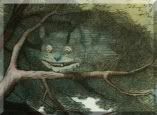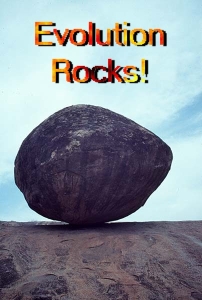Evolution Rocks!
Hundreds of years later some men come by and notice the great furrow cut in the surface of the hill. The furrow is incomplete because over time parts of it have weathered away, and a subsequent landslide has destroyed portions of it, and there were times when the boulder was airborne. The rock itself lay hidden beneath the muddy floor of the lake. The men try to explain what caused this furrow. One man, the theist, says that God created the furrow. The other men like this idea and they go back to their village and spread the good word, culminating in Fred Franklin writing a book that tells about God creating the furrow.
Several hundred years after that a theist and a scientist come to visit the furrow.
The scientist climbs the hill and studies the rock at the top. He tests rolling small rocks in various places on the hill’s surface. He studies the sides of the furrow and compares them to pictures of furrows created when other boulders rolled down other hills. After much study, he announces that something massive, probably a large boulder or a slab of stone, slid or rolled down the surface of the hill sometime in the past.
The theist points to the missing areas of the furrow and says “If a rock rolled down the hill, where is the evidence here? There are gaps in your evidence, and therefore you must be wrong, and God must have done it.”
The scientist explains that (a) even if his hypothesis is incorrect, that doesn’t mean that the “God hypothesis” is correct, and (b) it’s possible that over time that some of the furrow would be filled in by landslides or other sorts of erosion.
The theist refuses to abandon the God hypothesis (despite the fact that there is no proof.) So the scientist takes a pick and a shovel and digs up a spot in the center of the landslide. Sure enough eventually he uncovers evidence of the rolling boulder beneath several feet of gravel and dirt, a deely gouged stone and compacted dirt matching the profile of the furrow above and below the slide.
“See?” he says.
“See what?” the theist says.
So the scientist removes the rest of the landslide. It takes many days, but it reveals the furrow like structure almost the entire length of the formerly covered area. In the meantime, while the scientist is doing real work, the theist preaches and glorifies the greatness of the god that cut the furrow. Once the landslide is removed the scientist identifies two thousand three hundred and seventy eight pieces of evidence that point to a large slab of stone rolling through that location following a path that connects up the furrow on both ends.
“See?” he says to the theist.
“See what?” the theist says.
The scientist shakes his head while wiping dirt and sweat from his brow. “No, and I’m not going to. I’ve amassed more than enough evidence to demonstrate that a boulder rolled down the entire length of this hill. There is enough evidence on either side of this gap to safely assume that the boulder which caused impact #1,536 also caused scrape #1,537.”
“Your theory has holes in it. How can you accept that?”
“You’re not thinking, sir. The only way to be 100% certain that a boulder rolled down this hill would be to go back in time and watch it happen. That’s clearly impossible. Over time some of the evidence will be destroyed, and therefore gathering all of the evidence after the fact is similarly impossible. Nonetheless I’ve been able to find enough evidence to support that hypothesis.”
“Why should I take your word for it?”
“Oh you shouldn’t. It’s still a hypothesis. Now I need to publish my findings, those findings will have to be reviewed by other scientists, and they will need to come here and conduct their own experiments to see if I’m right or wrong. They will likely perform other sorts of tests that I haven’t thought of, they may propose alternative hypotheses that will need to be tested, and I will need to stay out of their way and let them work. Only after my findings have been independently reproduced and thoroughly reviewed and confirmed will my hypothesis become a theory.”
“And then it is simply accepted as fact?”
“Oh no, theories can be and are challenged all the time. Over time through scientific advances we come up with new and better ways to test old theories. The best theories will endure the test of time.”
“So when will you know for sure?”
“I don’t understand?”
“When will you be able to say beyond all shadow of any doubt that a giant boulder rolled down this hill?”
“Never. Science doesn’t deal in 100% certainties, only in probabilities. Personally I’m 90% certain a boulder rolled down this hill, science will never be certain. Science may approach 100% certainty, but it can never say ‘for sure’… new information may be found in the future that casts an accepted theory into doubt. That’s why Science is so wonderful, it’s not doctrinal… it’s open to new information.”
“So you admit you can’t prove with 100% certainty that a rolling boulder did this.”
“Yes, of course I admit that.”
“Then I can’t see why you would expect me to believe that. I am 100% certain that God created that furrow.”
“Well what evidence can you provide to support your hypothesis?”
The theist pulls his holy book from his pack, opens it, and begins to read. “Yea and verily, it was upon the morning of the ninth day that The Lord touched the great hill with the tip of his divine finger and scratched a long furrow in it leading to the lake and said. ‘See how I your God have marked this hill. Look upon this mark and remember it is I who …’”
“I’m still waiting for evidence,” the scientist interrupts.
The theist holds up the book. “This is the word of God.”
“That is the word of Freddie Franklin. The fact that he wrote that story to explain the great furrow is interesting from an anthropological perspective, but it doesn’t amount to proof either way. Besides, I can provide evidence that this furrow is 750 years old. Freddie Franklin only lived 300 years ago, so he didn’t see it being formed. Therefore I repeat, where is your evidence?”
The theist flips to another page and begins reading again. “I stood upon the Earth and trembled as God cut the furrow in the soil …”
The scientist interrupts again. “That’s not evidence dammit. You can read that book from end to end and it doesn’t amount to one iota of evidence beyond ’someone said so’.”
“Well where is YOUR evidence?” the theist demands.
“Are you kidding? I just spent two weeks digging up this…”
“No, I know you’ve uncovered a few scattered bits of evidence to support your delusional rolling boulder idea, but where is your evidence that God DIDN’T create this furrow?”
“Why on Earth would I ever try and prove that?”
“What?”
“Science reaches conclusions which fit the evidence. You have a conclusion based on no evidence at all. That’s not science, it’s storytelling, and I can’t see why you would expect me to disprove it. I’m not the one making an outrageous claim here. You’re the one who is claiming an invisible supernatural being made this feature. That’s one hefty claim, and you need to prove that it is true.”
“You don’t seek proof of the almighty… that would be blasphemy.”
“I’m not asking you to prove the existence of your supernatural entity of choice, I am asking you to prove that this furrow was created by a supernatural entity. And DON’T start reading from that book again. That’s not evidence.”
“This is all the evidence I have, and it’s the only evidence I need.”
And off the theist goes to his village to profess how Science was unable to disprove that God made the great furrow. Leaving the exhausted and exasperated scientist to shake his head and get back to work discovering the truth.
So it is with evolution my friend. The amount of evidence which has been gathered which supports evolution is overwhelming. It is a truly phenomenal quantity of evidence. It is more than enough evidence to allow one to safely assume that A evolved to B even when there is a gap in the evidence between A and B.
And, as the scientist notes in the above story, gaps in the evidence for evolution do not equal proof of creationism. If someone managed to scientifically disprove evolution as we understand it today, that would not mean that creationism is proven. Creationism would be just as much poppycock then as it is now.
god of the gaps , evolution , creationism , god , science , creation
"Like A Rolling Stone" - (Dylan Cover) by A Beggar's Opera
























